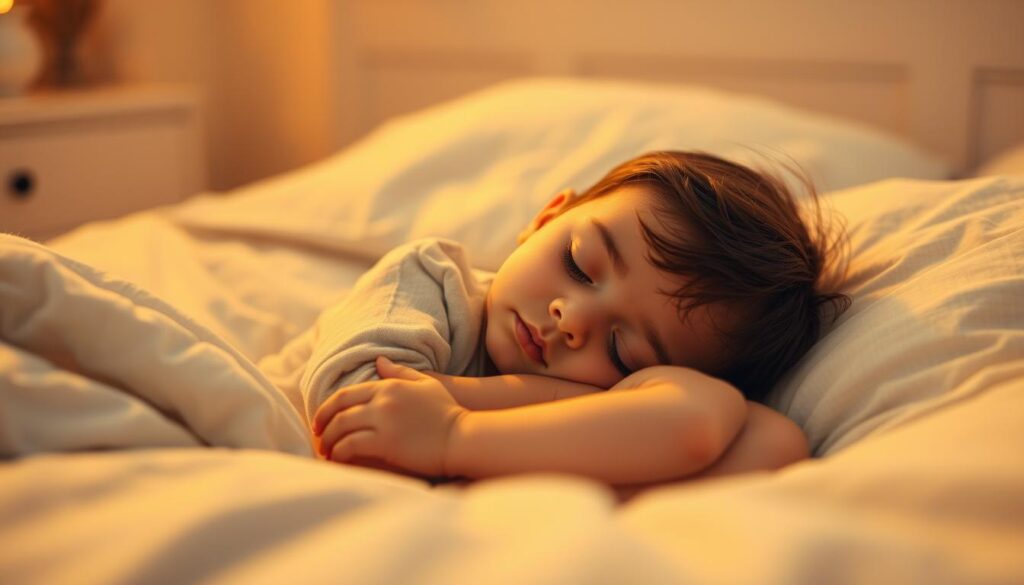Are you tired of co-sleeping with your baby and wondering when they’ll finally fall asleep on their own? You’re not alone!
Nearly 50% of parents co-sleep at some point during their child’s first year, often out of necessity. However, getting your little one to sleep independently is a crucial skill that benefits the whole family.
Independent sleep isn’t just about convenience; it’s linked to better cognitive development, improved mood, and healthier sleep patterns. In this guide, we’ll walk you through understanding independent sleep, recognizing when your child is ready, and implementing effective strategies to help them master this skill.
Understanding Independent Sleep and Its Importance
Teaching your child to sleep independently is one of the most valuable skills you can impart. As a parent, it’s natural to want to ensure your child’s comfort and safety, but it’s equally important to recognize when it’s time to encourage independence in sleep.
What Is Independent Sleep?
Independent sleep refers to your child’s ability to fall asleep on their own without requiring parental assistance like rocking, feeding, or holding. It’s about developing self-soothing skills that allow your child to transition smoothly into sleep.
When a baby falls asleep without extra help, research shows they experience longer stretches of sleep at night, better naps, and fewer early morning wakings. On the other hand, babies who are held, rocked, or fed to sleep have more night wakings, need more help falling back to sleep, and take shorter naps.
Benefits for Your Child’s Development
Your child’s brain doubles in size in their first year, and most of that growth happens during sleep. Quality sleep is crucial for cognitive development, memory formation, and emotional regulation. Studies show that babies who learn to fall asleep independently experience longer sleep stretches, better quality sleep, and fewer night wakings, directly supporting their neurological development.
| Benefits of Independent Sleep | Impact on Child’s Development |
|---|---|
| Longer sleep stretches at night | Improved cognitive development |
| Better quality sleep | Enhanced memory formation |
| Fewer night wakings | Better emotional regulation |
How Independent Sleep Improves Family Well-being
Independent sleep isn’t just beneficial for your child; it improves the entire family’s well-being by reducing parental sleep deprivation, lowering stress levels, and creating more predictable daily routines. Research has shown a reduction in maternal depression, anxiety, and stress when a baby’s sleep improves, creating a healthier emotional environment for the whole family.
Learning to fall asleep independently is a valuable life skill that builds your child’s confidence and self-regulation abilities that extend beyond just sleep time. By understanding and supporting your child’s journey to independent sleep, you’re not only enhancing their sleep quality but also contributing to their overall development and your family’s well-being.
When Is Your Child Ready for Independent Sleep?
Understanding when your child is developmentally ready for independent sleep is key to a smooth transition. As a parent, it’s essential to recognize the signs and milestones that indicate your child is ready to sleep independently.
Developmental Milestones to Watch For
Around 3-4 months, babies experience significant sleep development milestones. Their sleep cycles begin to organize and resemble adult sleep patterns, making this an ideal window to introduce independent sleep skills. You can start by observing your baby’s ability to self-soothe and stay awake for longer periods between sleeps.

Age-Appropriate Expectations
Newborns (0-3 months) naturally need assistance falling asleep as their circadian rhythms are still developing. For toddlers, readiness may look different; they understand more language, can follow simple directions, and may show interest in doing things “by myself,” which can be channeled into independent sleep.
Signs Your Child Might Be Ready
Watch for signs that your baby is ready for independent sleep: they can bring their hands to their mouth, self-soothe briefly, and may show frustration with previous sleep associations. For more information on normal baby sleep patterns, you can visit this resource. Each child develops at their own pace, so it’s crucial to observe your individual child rather than focusing solely on age.
By recognizing these signs and understanding your child’s developmental readiness, you can help them transition to independent sleep more effectively.
Common Challenges in the Child Transition to Independent Sleep
Transitioning your child to independent sleep can be challenging, but understanding the common hurdles can make the process smoother. As you embark on this journey, you’ll likely encounter several obstacles that can be addressed with the right strategies.
Transitioning from Co-Sleeping
For many families, co-sleeping is a comfortable and convenient arrangement. However, transitioning from co-sleeping to independent sleep requires thoughtful planning. It’s helpful to talk to your child about the move, introduce a security object, and consider spending a few nights in their room before beginning the transition. This gradual approach can make the change less daunting for your child.
Dependency on Rocking, Feeding, or Pacifiers
Many children develop sleep associations with activities like rocking, feeding, or using pacifiers. To break these associations, try moving these activities earlier in the bedtime routine and placing your child in their sleep space drowsy but still awake. For example, if your child is used to being rocked to sleep, you can start by rocking them until they’re drowsy, then placing them in bed.
Handling the 4-Month Sleep Regression
Around 4 months, babies undergo significant developmental changes, including the maturation of their sleep cycles. This can lead to more frequent wake-ups and is often referred to as the 4-month sleep regression. Understanding that this is a normal part of development can help you navigate this challenging period. For more information on weaning off bedtime bottles, you can visit this resource.
Addressing Separation Anxiety
Separation anxiety typically peaks around 8-10 months and can resurface during toddlerhood. Responding with reassurance while maintaining boundaries is key. Using consistent check-ins that gradually decrease in frequency can help your child feel secure and adjust to independent sleep.
| Challenge | Strategy |
|---|---|
| Co-Sleeping | Gradual transition, security object |
| Sleep Associations | Move activities earlier in bedtime routine |
| 4-Month Sleep Regression | Understand it’s a normal developmental phase |
| Separation Anxiety | Reassurance, gradual check-ins |
By understanding these common challenges and implementing the right strategies, you can help your child transition to independent sleep more smoothly.
Creating the Optimal Sleep Environment
Creating a sleep-conducive environment is crucial for your child’s ability to sleep independently. A well-designed sleep space can significantly impact the quality of your child’s sleep, making it easier for them to fall asleep and stay asleep throughout the night.
Safety First
To create an optimal sleep environment, start with safety. Ensure the crib or bed meets current safety standards, with a firm mattress and no loose bedding, pillows, or stuffed animals for babies under 12 months. This not only reduces the risk of SIDS but also creates a comfortable sleep space for your baby.
Temperature, Lighting, and Sound Considerations
The room’s temperature, lighting, and sound levels play a significant role in creating a sleep-friendly environment. Aim for a cool room temperature between 68-72°F (20-22°C) to prevent overheating, which can disrupt sleep. Darkness is also crucial as it triggers natural melatonin production. Consider installing blackout curtains and using a dim red nightlight if necessary. A consistent white noise machine can help mask household sounds, creating a soothing background that aids your child in falling asleep and staying asleep.

Choosing the Right Sleep Space
For children under 2½ years, a crib is often the best choice, even when transitioning from co-sleeping. Toddlers typically lack the self-control needed to stay in a big bed all night without boundaries. A crib provides a safe and contained sleep space that can help your child understand that it’s time for sleep.
Introducing Comfort Objects
Introducing a comfort object like a small blanket or a stuffed animal (for children over 12 months) can become associated with sleep and provide security during the transition to independent sleep. This comfort object can be a valuable tool in helping your child feel secure and relaxed in their sleep environment.
Consider the overall feel of the room as well. Keep toys and stimulating items out of sight during sleep times to avoid distraction and reinforce that the bedroom is for sleeping. By creating a calm, distraction-free environment, you can help your child develop healthy sleep habits that will benefit them for years to come.
| Factor | Ideal Condition | Benefit |
|---|---|---|
| Temperature | 68-72°F (20-22°C) | Prevents overheating, reducing SIDS risk |
| Lighting | Darkness with dim red nightlight if needed | Triggers natural melatonin production |
| Sound | Consistent white noise | Masks household sounds, aids sleep |
Establishing Effective Sleep Routines
A well-designed bedtime routine is the cornerstone of healthy sleep habits for children. It’s a signal to your child’s brain that it’s time to sleep, and it can be incredibly beneficial even before they fully understand the routine.
Designing Age-Appropriate Bedtime Routines
Bedtime routines don’t have to be complicated. A simple sequence of calming activities can be very effective. For example, you can start with feeding, followed by a diaper change, swaddling or using a sleep sack, singing a lullaby, and then placing your baby in their crib. The key is to keep the feeding towards the beginning of the routine to create a gap between feeding and sleeping.
Keep routines simple and sustainable. A 20-30 minute sequence of calming activities like a warm bath, changing into pajamas, reading a book, and a goodnight song provides predictability without becoming overwhelming. For newborns, routines might be shorter and simpler, while toddlers benefit from clear boundaries and may need help transitioning from active play to quiet time before bedtime begins.
The Importance of Consistency
Consistency is crucial when it comes to bedtime routines. Research shows that children with regular bedtime routines fall asleep faster, wake less during the night, and get more total sleep. Consistency extends beyond bedtime to naps and wake times. Maintaining regular wake windows appropriate for your child’s age helps regulate their internal clock and prevents overtiredness.
Separating Feeding from Falling Asleep
It’s essential to separate feeding from falling asleep. Move nursing or bottle feeding to the beginning of the routine to break the feed-to-sleep association. This way, your child learns to fall asleep independently while still getting the nutrition they need.
Managing Daytime Schedules and Wake Windows
Pay attention to your child’s natural rhythm and sleepy cues, such as eye rubbing, ear pulling, or decreased activity. Finding the optimal schedule that works with their biological sleep needs is key. The bedtime routine should end with placing your child in their sleep space drowsy but awake, giving them the opportunity to practice falling asleep independently.
Sleep Training Methods for Independent Sleep
Sleep training is an essential process that enables your child to learn how to fall asleep and stay asleep without your assistance. It’s a journey that requires patience, consistency, and the right approach. By understanding and implementing effective sleep training methods, you can help your child develop healthy sleep habits that will benefit them throughout their lives.
Gentle Approaches for Younger Babies
For younger babies, typically between 4 to 6 months old, gentle sleep training approaches can be highly effective. Methods like the “Pick-Up/Put-Down” technique or the “Shush-Pat” method provide reassurance while encouraging self-soothing skills. These gentle approaches help your baby learn to fall asleep independently without feeling abandoned or distressed.
Some parents find that establishing a bedtime routine that includes calming activities like bath time, reading, or singing can also be beneficial. For more information on handling bedtime challenges, you can visit this resource for additional guidance.
Behavioral Fading Techniques
Behavioral fading techniques, such as the “Sleep Lady Shuffle” or “Camping Out” method, involve gradually reducing your presence in the room over time. This allows your child to adjust incrementally to falling asleep independently. By slowly fading your involvement, you’re helping your child learn to self-soothe and fall asleep without relying on your presence.
Gradual Withdrawal Methods
Gradual withdrawal methods focus on slowly changing one aspect of your child’s sleep association. For example, if you typically rock your child to sleep, you might start by rocking until they’re drowsy, then place them in their crib awake, gradually reducing the rocking time over subsequent nights. This method helps your child adjust to the change gradually, making it easier for them to learn to fall asleep independently.
Addressing Crying and Emotional Concerns
It’s essential to acknowledge that some crying is a normal part of the sleep training process, as it’s your baby’s primary form of communication. However, research shows that short-term stress during sleep training does not cause long-term harm when implemented in a loving, supportive environment. Choosing a method that aligns with your parenting philosophy and your child’s temperament is crucial. Consistency is key to success, with studies showing that 94% of behavioral sleep interventions are effective when applied consistently.
- Gentle sleep training methods can be effective for younger babies, promoting self-soothing skills.
- Behavioral fading techniques gradually reduce your presence, helping your child adjust to independent sleep.
- Gradual withdrawal methods involve changing sleep associations gradually, making it easier for your child to adapt.
- Consistency is crucial for the success of any sleep training method.
Troubleshooting Common Sleep Issues
As you navigate your child’s sleep journey, you may encounter several challenges that require patience and understanding. Sleep issues can arise from various factors, and addressing them effectively is crucial for your child’s well-being and your family’s overall quality of life.
Dealing with Night Wakings
Night wakings are a normal occurrence for all humans, but the key difference lies in whether your child can return to sleep independently or needs assistance. To address this, use the same method at bedtime and for night wakings. For instance, if your baby is used to being rocked to sleep, try to establish a consistent routine that helps them learn to self-soothe.
Handling Early Morning Wake-Ups
Early morning wake-ups, often before 6 AM, can result from overtiredness, inappropriate bedtimes, or excessive light in the room. To tackle this, adjust bedtime earlier, ensure the room is completely dark, and maintain a consistent wake time. This helps regulate your child’s internal clock and improves the quality of their sleep.
Nap Transitions and Challenges
Nap transitions can temporarily disrupt nighttime sleep. Watch for signs that your child is ready to drop a nap, such as fighting the nap or taking too long to fall asleep, and adjust gradually. Ensuring appropriate wake windows and consistent pre-nap routines can also help mitigate nap challenges.
When to Seek Professional Help
If your child experiences persistent sleep difficulties despite consistent efforts, or shows signs of sleep disorders like sleep apnea or excessive snoring, consider seeking professional help. Additionally, if sleep issues affect their daytime behavior or development, or if you’re feeling overwhelmed, it’s time to consult a professional.
Conclusion: Supporting Your Family Through the Sleep Transition
As you navigate the journey of helping your child transition to independent sleep, it’s essential to remember that this process is a valuable investment in their development and your family’s overall well-being.
Studies have shown that when a baby’s sleep improves, there’s a significant reduction in a mother’s depression, anxiety, and stress. This improvement can have a ripple effect, allowing the entire family to thrive.
Some key takeaways to keep in mind: Helping your child learn to fall asleep independently is a gift that benefits their development and your entire family’s well-being. The transition to independent sleep is rarely linear, so be prepared for progress, setbacks, and further progress. Trust your instincts as parents and remain consistent in your approach.
By supporting your child through this journey, you’re not just solving a sleep issue; you’re teaching a vital life skill that will benefit them for years to come. And as your child learns to fall asleep in their bed, you’ll likely see an improvement in overall sleep quality for everyone.
FAQ
How do I know if my baby is ready to start sleep training?
You can gauge readiness by looking for developmental milestones, such as the ability to self-soothe and a regular daytime schedule. Typically, babies are ready around 4-6 months of age.
What’s the best way to create a bedtime routine that works for my toddler?
Establishing a calming and predictable bedtime routine is key. This can include activities like bath time, reading, singing, and cuddling. Be sure to tailor the routine to your toddler’s age and needs, and stick to it consistently.
My baby wakes up multiple times during the night. How can I help them fall back asleep?
Try to establish a consistent sleep environment and routine. If your baby wakes up, give them a minute to self-soothe before intervening. You can also try using comfort objects or a lovey to help them settle down.
Is it better to use a crib or a bed for my child to fall asleep in?
For younger babies, a crib is generally the safest and most recommended option. As your child gets older and more confident in their ability to navigate a bed, you can consider transitioning them to a bed.
How can I help my baby fall asleep during the day for naps?
Create a sleep-conducive environment by ensuring the room is dark, quiet, and at a comfortable temperature. Watch for your baby’s wake windows and put them down for a nap before they become overtired.
What’s the best way to handle separation anxiety at bedtime?
Establishing a consistent goodnight ritual can help. You can also try gradually increasing the amount of time you spend away from your child during the day to help them become more comfortable with your absence.
How long does it typically take for a baby to adjust to a new sleep schedule?
Every baby is different, but with consistency and patience, most can adjust to a new sleep schedule within a few weeks. Be prepared for some initial resistance and give your baby time to adapt.




